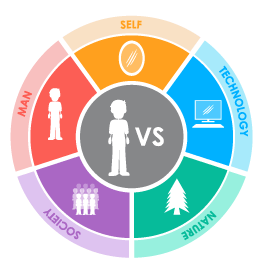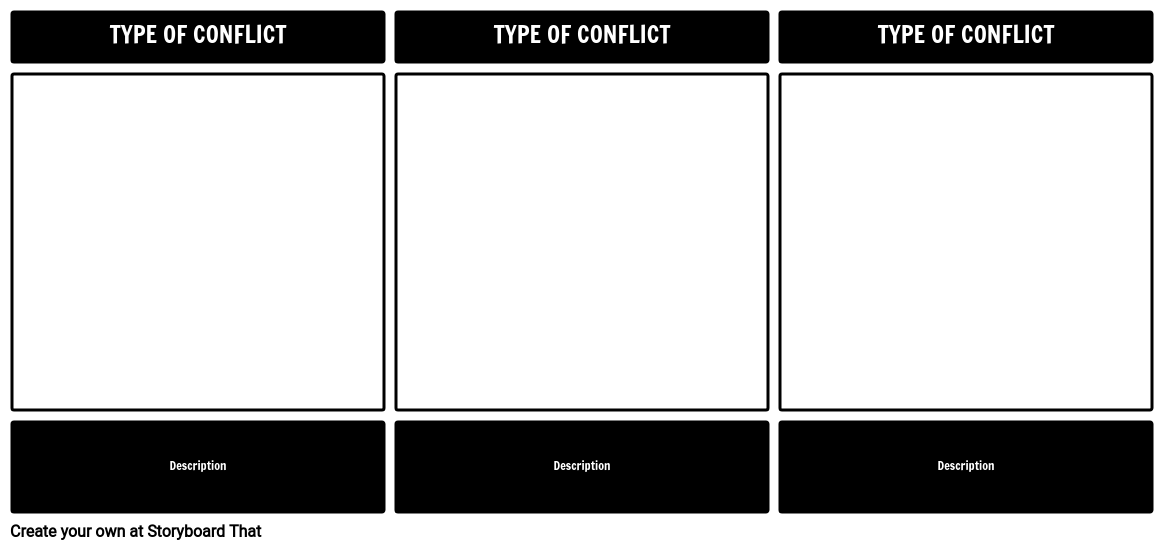Lesson Plan Overview
Storyboarding is a great way to focus on the various types of literary conflicts within different types of literature. Have students choose some examples of literary conflict, and depict them using the Storyboard Creator!
Examples of Conflict from Animal Farm
MAN vs. SELF: Boxer vs. Himself
Boxer worries about the farm, and blames himself. When Napoleon starts killing other animals, he says, "I would not have believed that such things could happen on our farm. It must be due to some fault in ourselves."
MAN vs. SOCIETY: The Animals vs. Humans
Old Major begins the ideology of "Animalism", which goes against the current way of life.
MAN vs. MAN: Napoleon vs. Snowball
These two pigs have it out for each other. As Napoleon becomes a tyrannical dictator, Snowball struggles to find order. Napoleon eventually uses brute force to run Snowball off the farm.
Template and Class Instructions
(These instructions are completely customizable. After clicking "Copy Activity", update the instructions on the Edit Tab of the assignment.)
Student Instructions
Create a storyboard that shows at least three forms of literary conflict in Animal Farm.
- Identify conflicts in Animal Farm.
- Categorize each conflict as Character vs. Character, Character vs. Self, Character vs. Society, Character vs. Nature, or Character vs. Technology.
- Illustrate conflicts in the cells, using characters from the story.
- Write a short description of the conflict below the cell.
Lesson Plan Reference
Student Rubric
(You can also create your own on Quick Rubric.)
| Proficient | Emerging | Beginning | Try Again | |
|---|---|---|---|---|
| Conflict Identification | Student identifies correct major conflicts and uses strong, clear textual evidence to support choice. | Student identifies correct major conflict and uses few or unclear details to support their choice. | Student identifies incorrect major conflict, and uses some details from the text to support their choice. | Student does not attempt to identify major conflict or identifies incorrect major conflict with no explanation. |
| Understanding Outcome | Student clearly shows the outcome of the conflict and its effects on the protagonist with evidence from the text. | Student shows the outcome of the conflict and its effect on the protagonist, but some evidence is unclear. | Student shows the outcome of the conflict, but does not examine its effect on the protagonist and uses some vague textual evidence. | Student does not clearly show the outcome of the conflict or use textual evidence. |
| Character | Storyboard includes all required characters and clearly names them. Goes above and beyond by adding additional details. | Storyboard includes all required characters and clearly names them. | Storyboard includes protagonist and antagonist but leaves out other required characters. | Storyboard does not include the names of required characters. |
| Storyboard | Student clearly shows effort to convey the setting the scene of the book | Student attempts to convey setting and scene of the book, but lacks some clarity. | Student does not clearly convey the setting and scene. | Student makes little or no attempt to convey the setting or scene. |
| Spelling and Grammar | Student uses exemplary spelling and grammar. There are no errors. | Student makes a minor error in spelling and grammar. | Student makes several minor errors in spelling and grammar. | Student makes many errors in spelling and grammar; little attempt at spellchecking. |
Lesson Plan Overview
Storyboarding is a great way to focus on the various types of literary conflicts within different types of literature. Have students choose some examples of literary conflict, and depict them using the Storyboard Creator!
Examples of Conflict from Animal Farm
MAN vs. SELF: Boxer vs. Himself
Boxer worries about the farm, and blames himself. When Napoleon starts killing other animals, he says, "I would not have believed that such things could happen on our farm. It must be due to some fault in ourselves."
MAN vs. SOCIETY: The Animals vs. Humans
Old Major begins the ideology of "Animalism", which goes against the current way of life.
MAN vs. MAN: Napoleon vs. Snowball
These two pigs have it out for each other. As Napoleon becomes a tyrannical dictator, Snowball struggles to find order. Napoleon eventually uses brute force to run Snowball off the farm.
Template and Class Instructions
(These instructions are completely customizable. After clicking "Copy Activity", update the instructions on the Edit Tab of the assignment.)
Student Instructions
Create a storyboard that shows at least three forms of literary conflict in Animal Farm.
- Identify conflicts in Animal Farm.
- Categorize each conflict as Character vs. Character, Character vs. Self, Character vs. Society, Character vs. Nature, or Character vs. Technology.
- Illustrate conflicts in the cells, using characters from the story.
- Write a short description of the conflict below the cell.
Lesson Plan Reference
Student Rubric
(You can also create your own on Quick Rubric.)
| Proficient | Emerging | Beginning | Try Again | |
|---|---|---|---|---|
| Conflict Identification | Student identifies correct major conflicts and uses strong, clear textual evidence to support choice. | Student identifies correct major conflict and uses few or unclear details to support their choice. | Student identifies incorrect major conflict, and uses some details from the text to support their choice. | Student does not attempt to identify major conflict or identifies incorrect major conflict with no explanation. |
| Understanding Outcome | Student clearly shows the outcome of the conflict and its effects on the protagonist with evidence from the text. | Student shows the outcome of the conflict and its effect on the protagonist, but some evidence is unclear. | Student shows the outcome of the conflict, but does not examine its effect on the protagonist and uses some vague textual evidence. | Student does not clearly show the outcome of the conflict or use textual evidence. |
| Character | Storyboard includes all required characters and clearly names them. Goes above and beyond by adding additional details. | Storyboard includes all required characters and clearly names them. | Storyboard includes protagonist and antagonist but leaves out other required characters. | Storyboard does not include the names of required characters. |
| Storyboard | Student clearly shows effort to convey the setting the scene of the book | Student attempts to convey setting and scene of the book, but lacks some clarity. | Student does not clearly convey the setting and scene. | Student makes little or no attempt to convey the setting or scene. |
| Spelling and Grammar | Student uses exemplary spelling and grammar. There are no errors. | Student makes a minor error in spelling and grammar. | Student makes several minor errors in spelling and grammar. | Student makes many errors in spelling and grammar; little attempt at spellchecking. |
How To Help Students Analyze Internal Conflicts in Animal Farm
Define Types of Conflicts
Begin by giving students simple and interesting definitions of different types of conflicts. First, explain the difference between internal and external conflict then gradually move to the different types of internal and external conflicts. Give students simple examples to familiarize them with the concept.
Identify Conflicts
After students are clear on the concept, help them identify the different types of conflicts in Animal Farm. Focus on the internal conflicts which are harder to identify and analyze. For instance, the conflict Boxer faces when he thinks he is to blame for Napoleon’s actions.
Explore the Reason of Conflict
Encourage the students to investigate the reason behind the internal conflict. Ask the students why they think Boxer blames himself or other animals and do they think would happen because of this conflict. Focus on analyzing the reason and consequences of the conflict.
Use a Holistic Approach
Connect the internal struggles to the story's overarching themes, which include loyalty, power, corruption, and the effects of revolution. Ask the students to connect these conflicts with the overall story to find out more about its emergence and future consequences.
Reflect and Discuss
Encourage students to offer their opinions and interpretations during class discussions. Encourage them to consider how crucial internal struggles were in forming the main characters and the story as a whole. Guide the students to discuss any internal conflicts they have faced recently and how they solved them.
Frequently Asked Questions About Animal Farm Literary Conflict
What part does the conflict of Character vs. Society play in the story?
A major conflict in "Animal Farm" is between man and society since the animals' uprising against human domination represents a larger social battle for equality and freedom. This contradiction is best shown by the development of animalism and the endeavor to build a just society. Students can focus on similar conflicts experienced during the Russian Revolution to understand the conflict between the animals and the human society in the story in a better way.
What is the significance of these conflicts in the general narrative of “Animal Farm”?
The struggles in "Animal Farm" aim to emphasize the difficulties and complexity of authority, revolt, and societal change. They show how internal and external disputes may affect a revolution's trajectory and its results. As the story progresses, we can see the development of these conflicts and how they enhance the plot as well as play a role in character development.
More Storyboard That Activities
Animal Farm
Testimonials

“By using the product, they were so excited and they learned so much...”–K-5 Librarian and Instructinal Technology Teacher

“I'm doing a Napoleon timeline and I'm having [students] determine whether or not Napoleon was a good guy or a bad guy or somewhere in between.”–History and Special Ed Teacher

“Students get to be creative with Storyboard That and there's so many visuals for them to pick from... It makes it really accessible for all students in the class.”–Third Grade Teacher
© 2026 - Clever Prototypes, LLC - All rights reserved.
StoryboardThat is a trademark of Clever Prototypes, LLC, and Registered in U.S. Patent and Trademark Office









